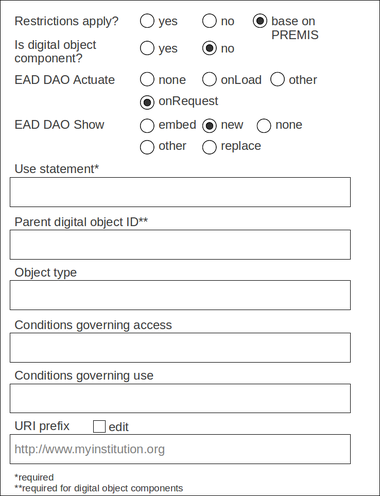Difference between revisions of "Archivists Toolkit integration"
Jump to navigation
Jump to search
| Line 11: | Line 11: | ||
#The user can edit the metadata in the text file if desired | #The user can edit the metadata in the text file if desired | ||
#The user manually imports the text file into Archivists' Toolkit | #The user manually imports the text file into Archivists' Toolkit | ||
| − | + | </br> | |
=DIP requirements= | =DIP requirements= | ||
| Line 18: | Line 18: | ||
**entered directly by the user from the data-entry form described above | **entered directly by the user from the data-entry form described above | ||
**auto-populated from metadata generated during processing | **auto-populated from metadata generated during processing | ||
| − | + | </br> | |
==Settings== | ==Settings== | ||
This screenshot shows the settings form in the admin tab, with some default settings: | This screenshot shows the settings form in the admin tab, with some default settings: | ||
| + | </br> | ||
| + | |||
[[File:Metadata_entry.png|380px|thumb|center|]] | [[File:Metadata_entry.png|380px|thumb|center|]] | ||
| Line 43: | Line 45: | ||
*'''existenceLocationOriginals''': automatically populate with AIP UUID | *'''existenceLocationOriginals''': automatically populate with AIP UUID | ||
</br> | </br> | ||
| − | |||
==RestrictionsApply: Base on PREMIS== | ==RestrictionsApply: Base on PREMIS== | ||
Revision as of 17:03, 7 February 2013
Main Page > Development > Requirements > Integration with Archivists' Toolkit
This feature will re-format a DIP for import into Archivists' Toolkit.
Workflow
- The user sets AT upload configuration options in the admin tab, via a menu called Archivists' Toolkit settings (see Settings, below)
- The user processes a SIP the same way that all SIPs are processed
- At the Upload DIP micro-service, the user selects "Upload to Archivists' Toolkit"
- A tab-delimited file generated from the settings called ATmetadata.txt is placed in the DIP
- The DIP is placed in /uploadedDIPs/AT/.
- The user can edit the metadata in the text file if desired
- The user manually imports the text file into Archivists' Toolkit
DIP requirements
- A DIP formatted for upload to Archivists' Toolkit consists of the objects plus a tab-delimited text file called ATmetadata.txt.
- The tab-delimited text file contains field values:
- entered directly by the user from the data-entry form described above
- auto-populated from metadata generated during processing
Settings
This screenshot shows the settings form in the admin tab, with some default settings:
ATmetadata.txt file
The tab-delimited file ATmetadata.txt will contain one row of metadata per digital object in the DIP. On DIP metadata upload, all of the metadata will be used to populate the digital object instances in AT as follows:
- restrictionsApply: TRUE or FALSE (see also RestrictionsApply: Base on PREMIS, below)
- isComponent: TRUE or FALSE
- eadDaoActuate: onRequest
- eadDaoShow: new
- useStatement: Image-Service [for example]
- objectType: If no data entered, leave emtpy
- conditionsGoverningAccess: If no data entered, automatically populate from PREMIS <rightsGrantedNote>. If there is no content in <rightsGrantedNote>, leave empty
- conditionsGoverningUse: If no data entered, leave empty
- digitalObjectID: If empty, automatically populate with file UUID
- title: Automatically populate with filename (without UUID)
- uri: Automatically populate with eg www.myinstitution.org/[UUID]-filename
- existenceLocationOriginals: automatically populate with AIP UUID
RestrictionsApply: Base on PREMIS
- If PREMIS <act>= Disseminate and PREMIS <restriction> = Allow, restrictionsApply = FALSE
- If PREMIS <act>= Disseminate and PREMIS <restriction> = Conditional, restrictionsApply = TRUE
- If PREMIS <act>= Disseminate and PREMIS <restriction> = Disallow, restrictionsApply = TRUE
- In addition, when restrictionsApply=TRUE, both eadDaoActuate and eadDaoShow will be set to “none.”
